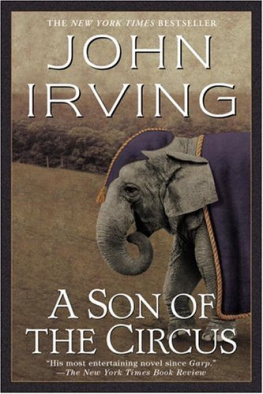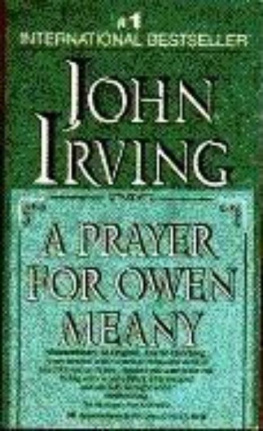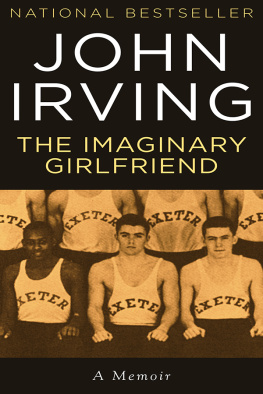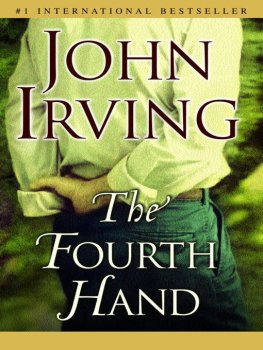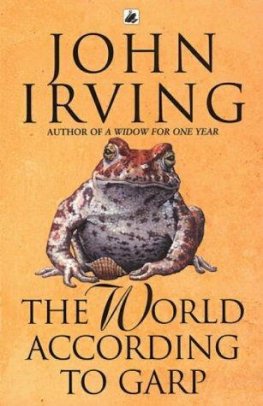John Irving - Avenue of Mysteries
Here you can read online John Irving - Avenue of Mysteries full text of the book (entire story) in english for free. Download pdf and epub, get meaning, cover and reviews about this ebook. year: 2015, publisher: Alfred A. Knopf Canada, genre: Detective and thriller. Description of the work, (preface) as well as reviews are available. Best literature library LitArk.com created for fans of good reading and offers a wide selection of genres:
Romance novel
Science fiction
Adventure
Detective
Science
History
Home and family
Prose
Art
Politics
Computer
Non-fiction
Religion
Business
Children
Humor
Choose a favorite category and find really read worthwhile books. Enjoy immersion in the world of imagination, feel the emotions of the characters or learn something new for yourself, make an fascinating discovery.

- Book:Avenue of Mysteries
- Author:
- Publisher:Alfred A. Knopf Canada
- Genre:
- Year:2015
- Rating:4 / 5
- Favourites:Add to favourites
- Your mark:
- 80
- 1
- 2
- 3
- 4
- 5
Avenue of Mysteries: summary, description and annotation
We offer to read an annotation, description, summary or preface (depends on what the author of the book "Avenue of Mysteries" wrote himself). If you haven't found the necessary information about the book — write in the comments, we will try to find it.
Avenue of Mysteries — read online for free the complete book (whole text) full work
Below is the text of the book, divided by pages. System saving the place of the last page read, allows you to conveniently read the book "Avenue of Mysteries" online for free, without having to search again every time where you left off. Put a bookmark, and you can go to the page where you finished reading at any time.
Font size:
Interval:
Bookmark:
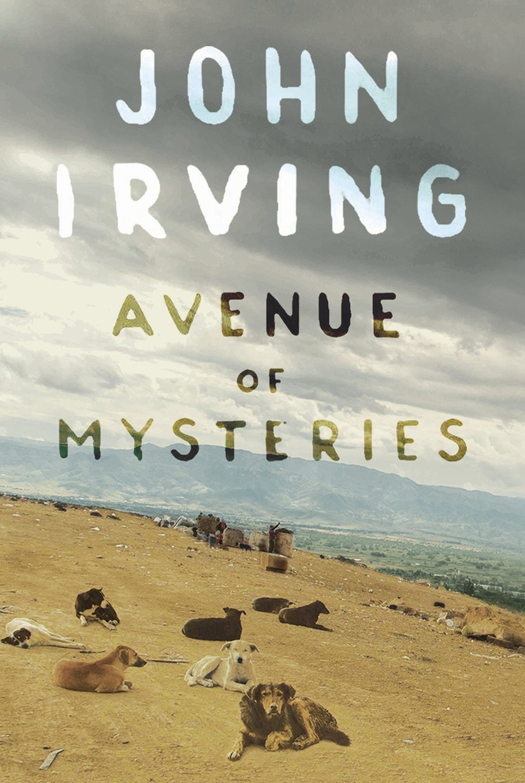
Setting Free the Bears
The Water-Method Man
The 158-Pound Marriage
The World According to Garp
The Hotel New Hampshire
The Cider House Rules
A Prayer for Owen Meany
Trying to Save Piggy Sneed
A Son of the Circus
The Imaginary Girlfriend
A Widow for One Year
My Movie Business
The Cider House Rules: A Screenplay
The Fourth Hand
A Sound Like Someone Trying Not to Make a Sound
Until I Find You
Last Night in Twisted River
In One Person
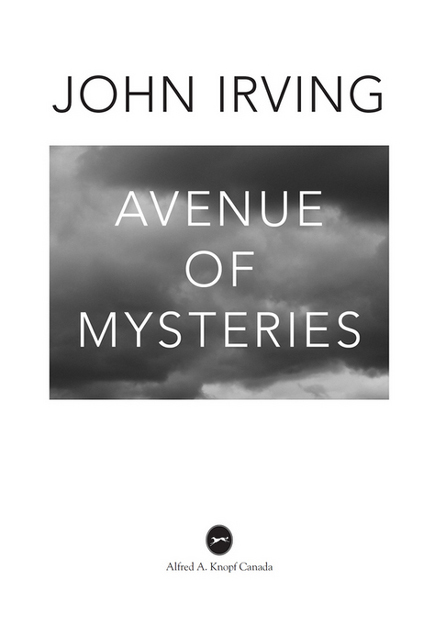
PUBLISHED BY ALFRED A. KNOPF CANADA
Copyright 2015 Garp Enterprises, Ltd.
All rights reserved under International and Pan-American Copyright Conventions. No part of this book may be reproduced in any form or by any electronic or mechanical means, including information storage and retrieval systems, without permission in writing from the publisher, except by a reviewer, who may quote brief passages in a review. Published in 2015 by Alfred A. Knopf Canada, a division of Penguin Random House Canada Limited, and simultaneously in the United States of America by Simon & Schuster, Inc. Distributed in Canada by Penguin Random House Canada Limited, Toronto.
www.penguinrandomhouse.ca
Alfred A. Knopf Canada and colophon are registered trademarks.
Library and Archives Canada Cataloguing in Publication
Irving, John,
Avenue of mysteries / John Irving.
ISBN 978-0-307-36181-3
eBook ISBN 978-0-307-36183-7
I. Title.
PS3559.R8A95 2015 813.54 C2015-902866-3
Title page image STILLFX / Shutterstock.com
Cover design adapted by CS Richardson from an original by Emily Pracher
Cover photo Karina Jurez

v3.1
For Martin Bell and
Mary Ellen Mark.
What we began together,
let us finish together.
Also for Minnie Domingo and
Rick Dancel, and their
daughter, Nicole Dancel,
for showing me the Philippines.
And for my son Everett,
my interpreter in Mexico,
and Karina Jurez,
our guide in Oaxaca
dos abrazos muy fuertes.
Journeys end in lovers meeting.
W ILLIAM S HAKESPEARE , Twelfth Night
Occasionally, Juan Diego would make a point of saying, Im a MexicanI was born in Mexico, I grew up there. More recently, he was in the habit of saying, Im an AmericanIve lived in the United States for forty years. Or, in an effort to defuse the nationality issue, Juan Diego liked to say, Im a midwesternerin fact, Im an Iowan.
He never said he was a Mexican American. It wasnt only that Juan Diego disliked the label, though he thought of it as such and he did dislike it. What Juan Diego believed was that people were always seeking a commonality with the Mexican-American experience, and he could find no common ground in his own experience; more truthfully, he didnt look for it.
What Juan Diego said was that hed had two livestwo separate and distinctly different lives. The Mexican experience was his first life, his childhood and early adolescence. After he left Mexicohed never gone backhe had a second life, the American or midwestern experience. (Or was he also saying that, relatively speaking, not a whole lot had happened to him in his second life?)
What Juan Diego always maintained was that, in his mindin his memories, certainly, but also in his dreamshe lived and relived his two lives on parallel tracks.
A dear friend of Juan Diegosshe was also his doctorteased him about the so-called parallel tracks. She told him he was either a kid from Mexico or a grown-up from Iowa all the time. Juan Diego could be an argumentative person, but he agreed with her about that.
B EFORE THE BETA - BLOCKERS HAD disturbed his dreams, Juan Diego told his doctor friend that he used to wake up to the gentlest of his recurrent nightmares. The nightmare he had in mind was really a memory of the formative morning he became a cripple. In truth, only the beginning of the nightmare or the memory was gentle, and the origin of this episode was something that happened in Oaxaca, Mexicoin the neighborhood of the city dump, in 1970when Juan Diego was fourteen.
In Oaxaca, he was what they called a dump kid (un nio de la basura); he lived in a shack in Guerrero, the colony for families who worked in the dump (el basurero). In 1970, there were only ten families living in Guerrero. At that time, about a hundred thousand people lived in the city of Oaxaca; many of them didnt know that the dump kids did most of the picking and sorting through stuff at the basurero. The children had the job of separating the glass, aluminum, and copper.
People who knew what the dump kids did called them los pepenadoresthe scavengers. At fourteen, that was who Juan Diego was: a dump kid and a scavenger. But the boy was also a reader; the word got around that un nio de la basura had taught himself to read. Dump kids werent the biggest readers, as a rule, and young readers of any origin or background are rarely self-taught. That was why the word got around, and how the Jesuits, who put such a high priority on education, heard about the boy from Guerrero. The two old Jesuit priests at the Temple of the Society of Jesus referred to Juan Diego as the dump reader.
Someone should bring the dump reader a good book or twoGod knows what the boy finds to read in the basurero! either Father Alfonso or Father Octavio said. Whenever one of these two old priests said someone should do anything, Brother Pepe was always the one who did it. And Pepe was a big reader.
In the first place, Brother Pepe had a car, and, because hed come from Mexico City, getting around Oaxaca was relatively easy for him. Pepe was a teacher at the Jesuit school; it had long been a successful schooleveryone knew the Society of Jesus was good at running schools. On the other hand, the Jesuit orphanage was relatively new (it had been less than ten years since theyd remodeled the former convent as an orphanage), and not everyone was crazy about the orphanages nameto some, Hogar de los Nios Perdidos was a long name that sounded a little severe.
But Brother Pepe had put his heart into the school and the orphanage; over time, most of those tender souls who objected to the sound of Home of the Lost Children would certainly admit that the Jesuits ran a pretty good orphanage, too. Besides, everyone had already shortened the name of the placeLost Children, people called it. One of the nuns who looked after the children was more blunt about it; to be fair, Sister Gloria must have been referring to a couple of misbehaving kids, not to all the orphans, when she muttered, occasionally, los perdidossurely the lost ones was a name the old nun intended for only a few of the more exasperating children.
Luckily, it was not Sister Gloria who brought the books to the basurero for the young dump reader; if Gloria had chosen the books and been their deliverer, Juan Diegos story might have ended before it began. But Brother Pepe put reading on a pedestal; he was a Jesuit because the Jesuits had made him a reader
Font size:
Interval:
Bookmark:
Similar books «Avenue of Mysteries»
Look at similar books to Avenue of Mysteries. We have selected literature similar in name and meaning in the hope of providing readers with more options to find new, interesting, not yet read works.
Discussion, reviews of the book Avenue of Mysteries and just readers' own opinions. Leave your comments, write what you think about the work, its meaning or the main characters. Specify what exactly you liked and what you didn't like, and why you think so.


